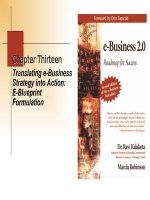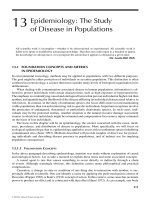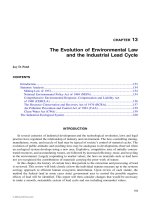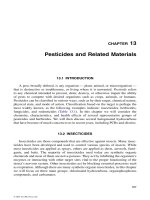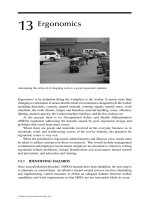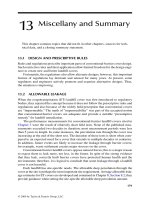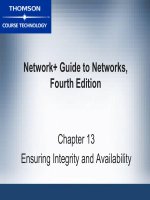Slide Financial Management - Chapter 13 pptx
Bạn đang xem bản rút gọn của tài liệu. Xem và tải ngay bản đầy đủ của tài liệu tại đây (195.56 KB, 44 trang )
13-1
CHAPTER 13
Capital Structure and Leverage
Business vs. financial risk
Optimal capital structure
Operating leverage
Capital structure theory
13-2
Uncertainty about future operating income (EBIT),
i.e., how well can we predict operating income?
Note that business risk does not include financing
effects.
What is business risk?
Probability
EBITE(EBIT)0
Low risk
High risk
13-3
What determines business risk?
Uncertainty about demand (sales).
Uncertainty about output prices.
Uncertainty about costs.
Product, other types of liability.
Operating leverage.
13-4
What is operating leverage, and how
does it affect a firm’s business risk?
Operating leverage is the use of
fixed costs rather than variable
costs.
If most costs are fixed, hence do not
decline when demand falls, then the
firm has high operating leverage.
13-5
Effect of operating leverage
More operating leverage leads to more
business risk, for then a small sales decline
causes a big profit decline.
What happens if variable costs change?
Sales
$
Rev.
TC
FC
Q
BE
Sales
$
Rev.
TC
FC
Q
BE
}
Profit
13-6
Using operating leverage
Typical situation: Can use operating leverage
to get higher E(EBIT), but risk also increases.
Probability
EBIT
L
Low operating leverage
High operating leverage
EBIT
H
13-7
What is financial leverage?
Financial risk?
Financial leverage is the use of debt
and preferred stock.
Financial risk is the additional risk
concentrated on common
stockholders as a result of financial
leverage.
13-8
Business risk vs. Financial risk
Business risk depends on business
factors such as competition, product
liability, and operating leverage.
Financial risk depends only on the
types of securities issued.
More debt, more financial risk.
Concentrates business risk on
stockholders.
13-9
An example:
Illustrating effects of financial leverage
Two firms with the same operating leverage,
business risk, and probability distribution of
EBIT.
Only differ with respect to their use of debt
(capital structure).
Firm U
Firm L
No debt
$10,000 of 12% debt
$20,000 in assets
$20,000 in assets
40% tax rate
40% tax rate
13-10
Firm U: Unleveraged
Economy
Bad Avg. Good
Prob. 0.25 0.50 0.25
EBIT $2,000 $3,000 $4,000
Interest 0
0 0
EBT $2,000 $3,000 $4,000
Taxes (40%) 800
1,200 1,600
NI $1,200 $1,800 $2,400
13-11
Firm L: Leveraged
Economy
Bad Avg. Good
Prob.* 0.25 0.50 0.25
EBIT* $2,000 $3,000 $4,000
Interest 1,200
1,200 1,200
EBT $ 800 $1,800 $2,800
Taxes (40%) 320
720 1,120
NI $ 480 $1,080 $1,680
*Same as for Firm U.
13-12
Ratio comparison between
leveraged and unleveraged firms
FIRM U
Bad
Avg
Good
BEP
10.0% 15.0% 20.0%
ROE
6.0% 9.0% 12.0%
TIE
∞∞ ∞
FIRM L
Bad
Avg
Good
BEP
10.0% 15.0% 20.0%
ROE
4.8% 10.8% 16.8%
TIE
1.67x 2.50x 3.30x
13-13
Risk and return for leveraged
and unleveraged firms
Expected Values:
Firm U
Firm L
E(BEP)
15.0%
15.0%
E(ROE)
9.0%
10.8%
E(TIE)
∞
2.5x
Risk Measures:
Firm U
Firm L
σ
ROE
2.12%
4.24%
CV
ROE
0.24
0.39
13-14
The effect of leverage on
profitability and debt coverage
For leverage to raise expected ROE, must
have BEP > k
d
.
Why? If k
d
> BEP, then the interest expense
will be higher than the operating income
produced by debt-financed assets, so
leverage will depress income.
As debt increases, TIE decreases because
EBIT is unaffected by debt, and interest
expense increases (Int Exp = k
d
D).
13-15
Conclusions
Basic earning power (BEP) is
unaffected by financial leverage.
L has higher expected ROE because
BEP > k
d
.
L has much wider ROE (and EPS)
swings because of fixed interest
charges. Its higher expected return
is accompanied by higher risk.
13-16
Optimal Capital Structure
That capital structure (mix of debt,
preferred, and common equity) at which P
0
is maximized. Trades off higher E(ROE)
and EPS against higher risk. The tax-
related benefits of leverage are exactly
offset by the debt’s risk-related costs.
The target capital structure is the mix of
debt, preferred stock, and common equity
with which the firm intends to raise capital.
13-17
Describe the sequence of
events in a recapitalization.
Campus Deli announces the
recapitalization.
New debt is issued.
Proceeds are used to repurchase
stock.
The number of shares repurchased is
equal to the amount of debt issued
divided by price per share.
13-18
Cost of debt at different levels of debt,
after the proposed recapitalization
Amount D/A D/E Bond
borrowed ratio ratio rating k
d
$ 0 0 0
250 0.125 0.1429 AA 8.0%
500 0.250 0.3333 A 9.0%
750 0.375 0.6000 BBB 11.5%
1,000 0.500 1.0000 BB 14.0%
13-19
Why do the bond rating and cost of debt
depend upon the amount borrowed?
As the firm borrows more money,
the firm increases its financial risk
causing the firm’s bond rating to
decrease, and its cost of debt to
increase.
13-20
Analyze the proposed recapitalization
at various levels of debt. Determine
the EPS and TIE at each level of debt.
$3.00
80,000
(0.6)($400,000)
goutstandin Shares
) T - 1 )( Dk - EBIT (
EPS
$0 D
d
=
=
=
=
13-21
Determining EPS and TIE at different
levels of debt.
(D = $250,000 and k
d
= 8%)
20x
$20,000
$400,000
Exp Int
EBIT
TIE
$3.26
10,000- 80,000
000))(0.6)0.08($250, - ($400,000
goutstandin Shares
) T - 1 )( Dk - EBIT (
EPS
10,000
$25
$250,000
drepurchase Shares
d
===
=
=
=
==
13-22
Determining EPS and TIE at different
levels of debt.
(D = $500,000 and k
d
= 9%)
8.9x
$45,000
$400,000
Exp Int
EBIT
TIE
$3.55
20,000- 80,000
000))(0.6)0.09($500, - ($400,000
goutstandin Shares
) T - 1 )( Dk - EBIT (
EPS
20,000
$25
$500,000
drepurchase Shares
d
===
=
=
=
==
13-23
Determining EPS and TIE at different
levels of debt.
(D = $750,000 and k
d
= 11.5%)
4.6x
$86,250
$400,000
Exp Int
EBIT
TIE
$3.77
30,000- 80,000
),000))(0.60.115($750 - ($400,000
goutstandin Shares
) T - 1 )( Dk - EBIT (
EPS
30,000
$25
$750,000
drepurchase Shares
d
===
=
=
=
==
13-24
Determining EPS and TIE at different
levels of debt.
(D = $1,000,000 and k
d
= 14%)
2.9x
$140,000
$400,000
Exp Int
EBIT
TIE
$3.90
40,000- 80,000
6)0,000))(0.0.14($1,00 - ($400,000
goutstandin Shares
) T - 1 )( Dk - EBIT (
EPS
40,000
$25
$1,000,000
drepurchase Shares
d
===
=
=
=
==
13-25
Stock Price, with zero growth
If all earnings are paid out as dividends,
E(g) = 0.
EPS = DPS
To find the expected stock price (P
0
), we
must find the appropriate k
s
at each of
the debt levels discussed.
sss
1
0
k
DPS
k
EPS
g - k
D
P ===
